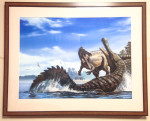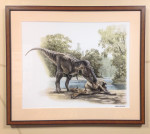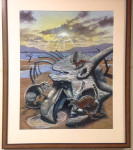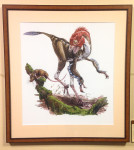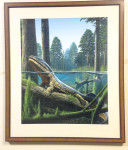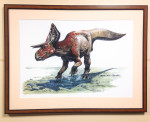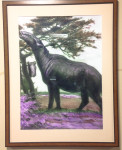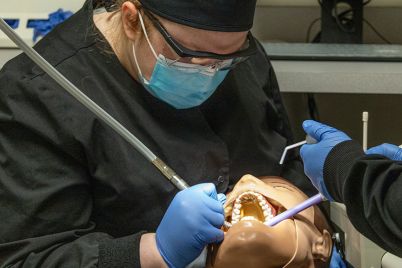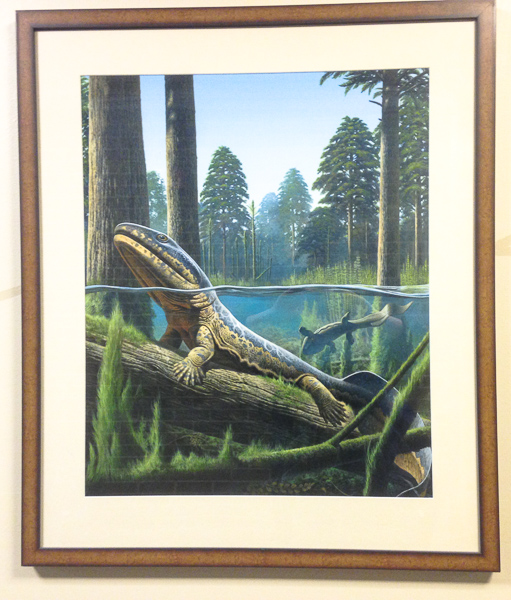
Raul Martin’s ‘Acanthostega’ represents a time when organisms began to climb onto the land and breathe air. Erin Fedeson | Washtenaw Voice
By ERIN FEDESON
Staff Writer
The 18 pictures that line the first-floor halls of Washtenaw’s Crane Liberal Arts and Sciences building are worth far more than a thousand words. They tell a story of life and death, going back millions of years.
These pictures, connected by curving branches, depict long-lost creatures from the Paleozoic Era.
Beyond the apparent artwork, there are three bands barely visible beneath the current paint. These three lines run along the hallway and end short of the physics wall display in the opposite hall.
They were the original timeline created during former WCC President Larry Whitworth’s time.
During his presidency, Whitworth hired Judith Homell as his executive assistant, said Pete Leshkevich, director of Student Development and Activities, who used to work as Homell’s technical assistant.
Homell wanted the walls to teach, so students could learn while they wait to get into their classes, Leshkevich explained.
At the time, David Thomas was a full-time faculty member for the Geology Department.
One of his students, Christy Janisch, was selected by Homell to paint the original linear timeline, with plant-eating dinosaurs and gingko trees toward the end of the hallway.
“I liked the connection as we have gingko trees and dinosaur tracks outside,” Thomas said.
Around 2010, David Wooten, a biology instructor, decided it was time to update the timeline.
The painting maintenance department painted over the original timeline, so Lana Campbell, a WCC student had a clean slate to paint the branches, which took about a week, she said.
The purpose of the branches and the pictures’ staggered appearance, was to show how evolution worked, Wooten explained. Some creatures branch off and become extinct, others continued on in the evolutionary process.
To give the timeline a more professional appearance, Wooten worked with Leshkevich and Homell to collect various works of art by paleo artists.
Paleo artists use art and science to represent what the extinct creatures might have looked like, as there was no evidence what dinosaurs looked like, Leshkevich explained.
Leshkevich had to contact the artists to obtain the rights to print. The cost of the paintings ranged from $100 to a several hundred dollars.
The artists ranged from those just beginning their career to those well established in their career, Leshkevich said.
The timeline begins at the Cambrian Explosion, which occurred around 550 million years ago, according to the information plaque next to Karen Carr’s “Cambrian Sea Mural.”
It concludes with three art pieces by Charles R. Knight, the information plaque entitling the collection as “Oligocene Mammals.”
The Oligocene Period was towards the end of the Paleozoic Era, which occurred from 33.9 to 23 million years ago, according to the University of California’s Museum of Paleontology.
While the artwork narrates a story from several million years ago, the wall stands as a testament to how art can tell more than one story.
- ‘Suchomimus and Sarcosuchus’ as illustrated by Raul Martin. Erin Fedeson | Washtenaw Voice
- Raul Martin’s ‘Albertosaurus and Lambeosaurus’ suggests the two beasts were more likely scavengers than predators. Erin Fedeson | Washtenaw Voice
- Sanaa Naeem | Washtenaw Voice
- The end of the Cretaceous period and the dawn of mammals is portrayed in Mark Hallet’s ‘Dawn of a New Day’ illustration. Erin Fedeson | Washtenaw Voice
- Eivind Bovor’s ‘Mei Long’ depicts a Theropod hunting a rat. Erin Fedeson | Washtenaw Voice
- Raul Martin’s ‘Acanthostega’ represents a time when organisms began to climb onto the land and breathe air. Erin Fedeson | Washtenaw Voice
- Sanaa Naeem | Washtenaw Voice
- In his understanding of the Zuniceratops, Eivind Bovor applied his own interpretation of the dinosaur’s color markings. Erin Fedeson | Washtenaw Voice
- The Baluchitherium was the largest terrestrial mammal to ever walk the Earth, presented here by Charles R. Knight in ‘Oligocene Mammals.’ Erin Fedeson | Washtenaw Voice

